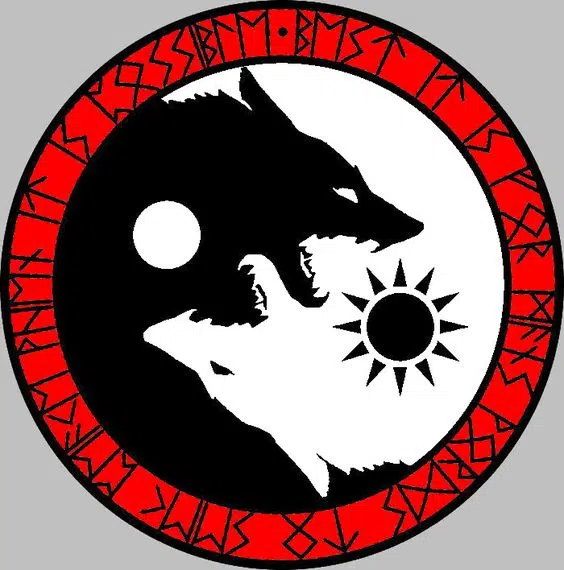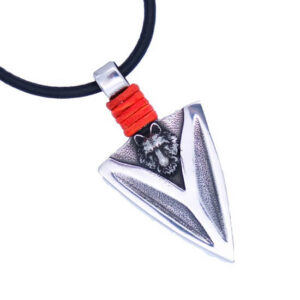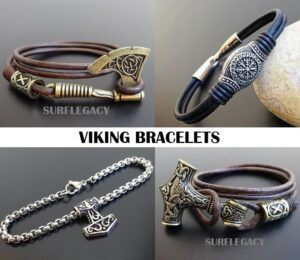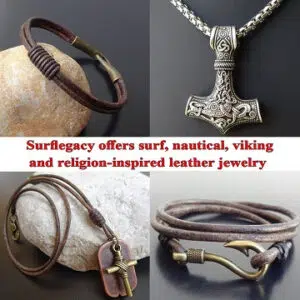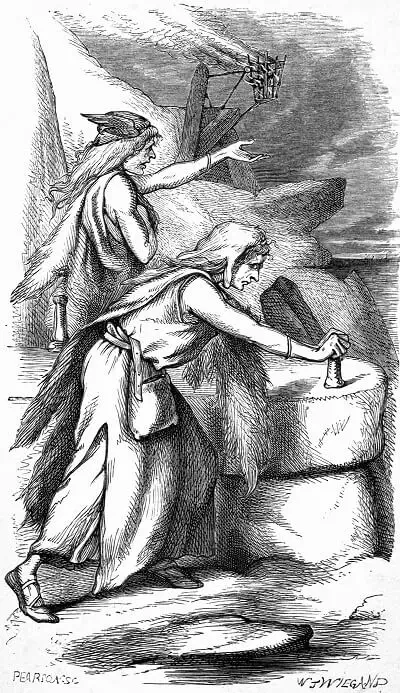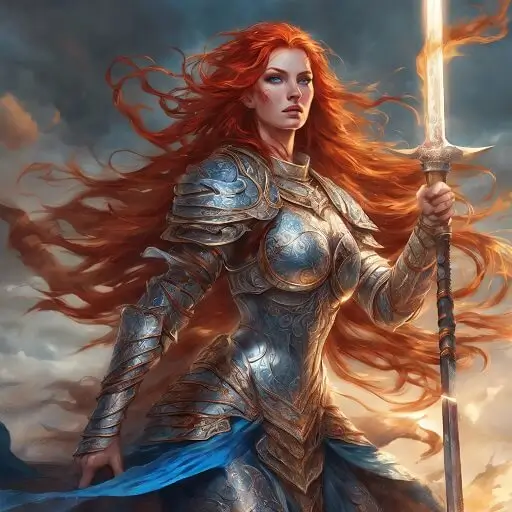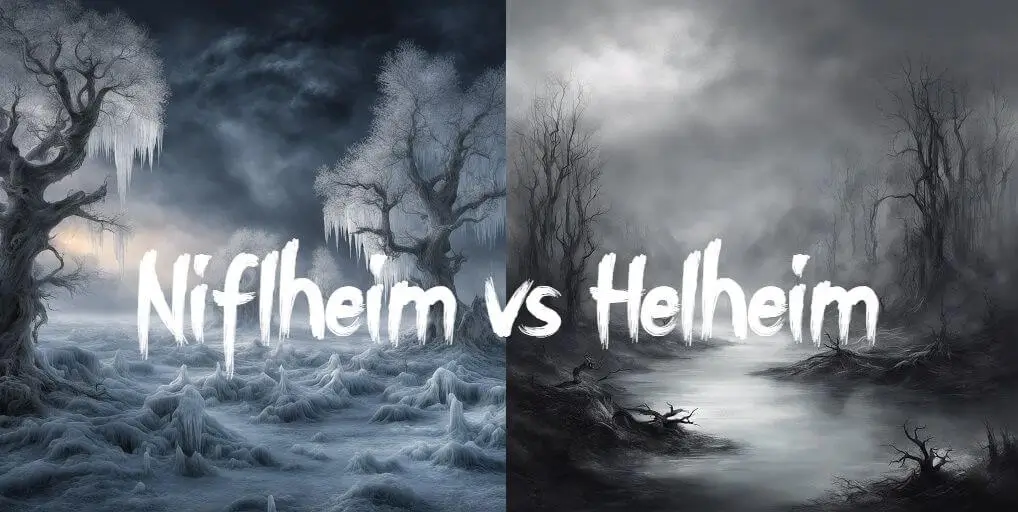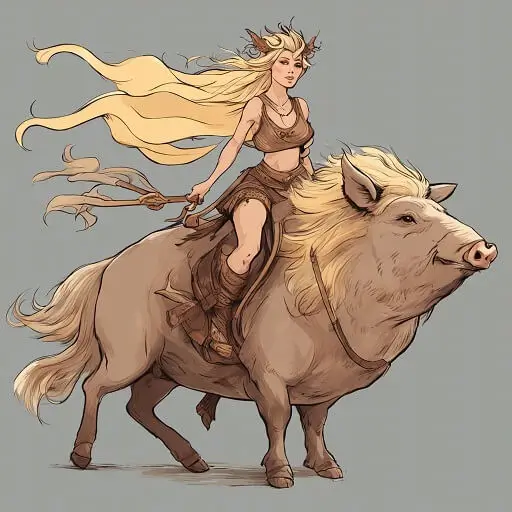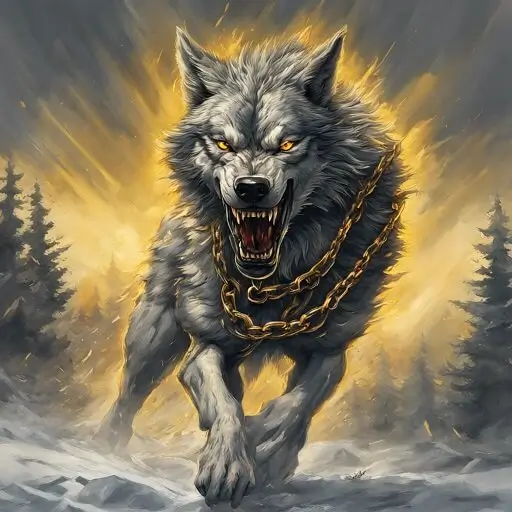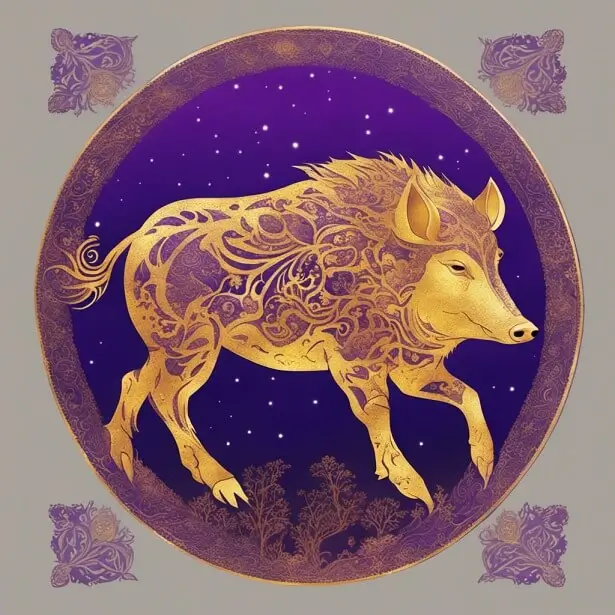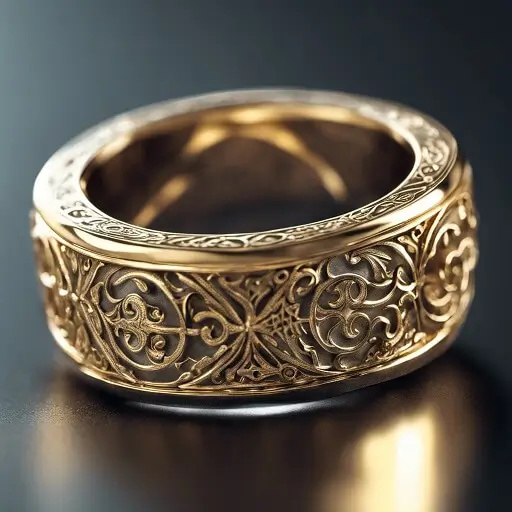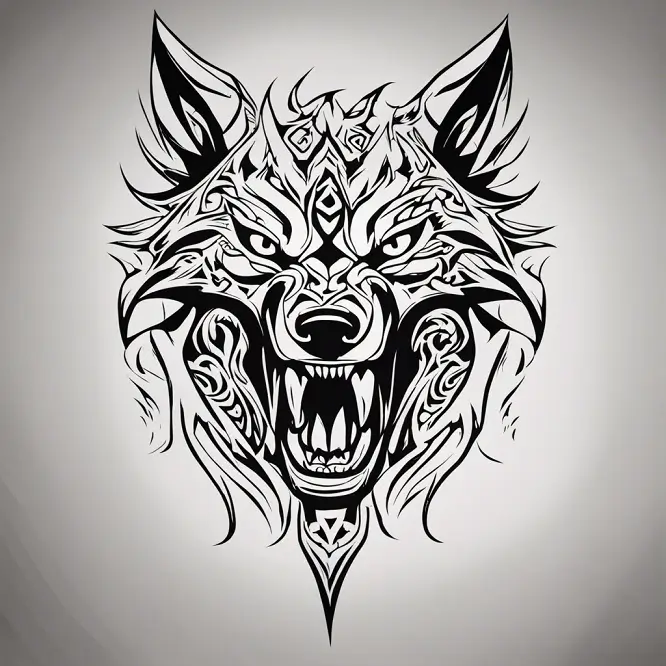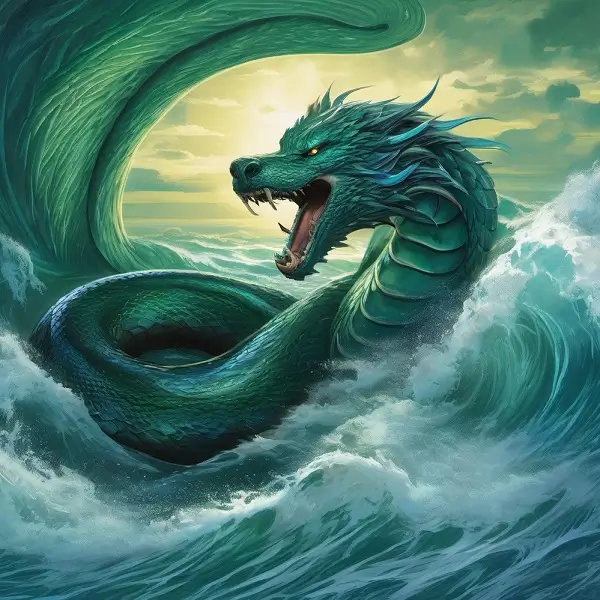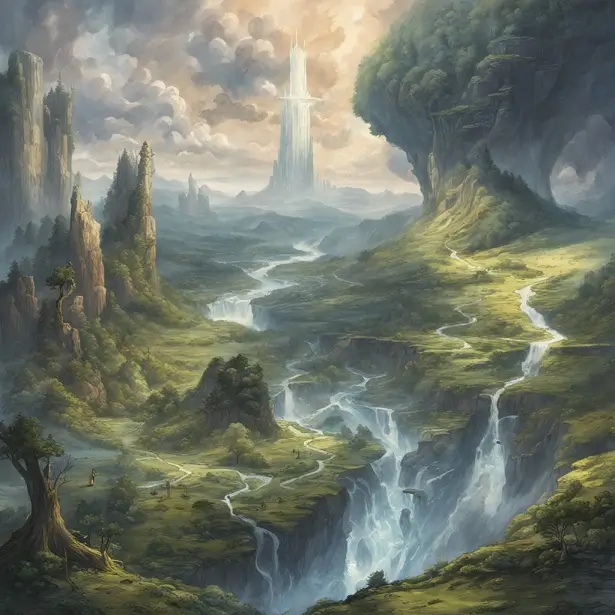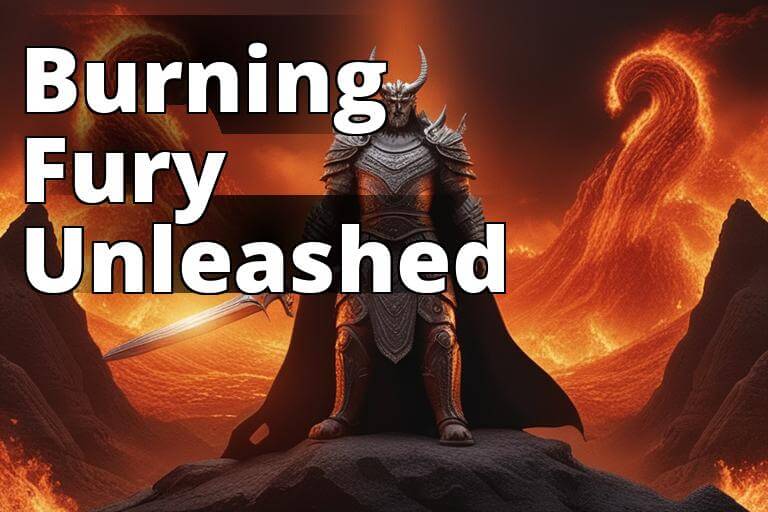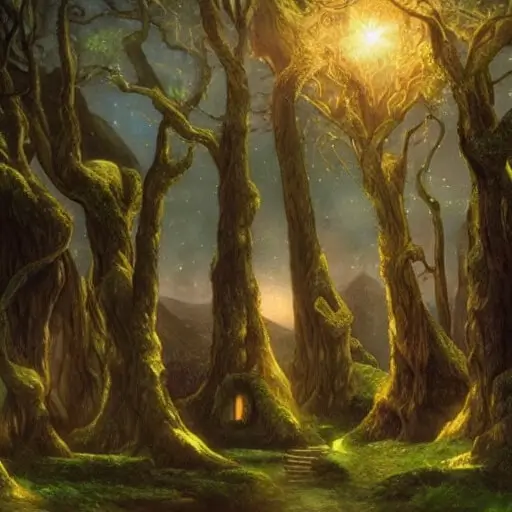In the captivating realm of Norse Mythology, Hati and Skoll stand out as two central figures that capture the imagination. These celestial wolves, forever chasing the sun and the moon, embody a compelling narrative that weaves itself into the very fabric of the ancient Norse belief system.
As Hati and Skoll relentlessly pursue their celestial targets, their story takes on deeper meaning, symbolizing the cyclical nature of time and the delicate balance between light and darkness. Furthermore, their pursuit foreshadows the cataclysmic events of Ragnarök, the prophesied end of the world.
In this blog post, we will delve into the rich mythology surrounding Hati and Sköll, exploring their origins, the symbolism of their celestial chase, and their role in the Norse apocalypse.
The Origins of Hati and Skoll
Their father, Fenrir, the monstrous wolf
Hati and Sköll’s lineage can be traced back to some of the most infamous figures in Norse Culture. Their father is none other than Fenrir, the monstrous wolf whose very existence was considered a harbinger of doom. Fenrir was born as a result of a union between the trickster god Loki and the giantess Angrboða. As one of the most feared creatures, Fenrir was prophesied to wreak havoc during Ragnarök, ultimately killing Odin, the chief of the gods.
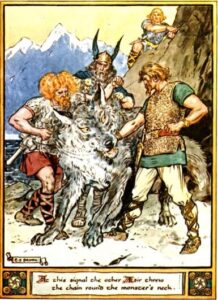
Fenrir biting Tyr’s hand
Their grandfather, Loki, the trickster god
Loki, the grandfather of Hati and Sköll, is also a complex and enigmatic figure in Norse mythology. As a shape-shifter and the god of mischief, Loki is often portrayed as both an ally and an enemy to the gods.
Although he is a member of the Æsir, the primary group of Norse gods, Loki’s bloodline can be traced back to the giants, making him a constant source of tension and conflict among the gods.
Loki fathered several monstrous offspring, including Fenrir, Jörmungandr (the Midgard Serpent), and Hel, the ruler of the realm of the dead. Through his connection to these fearsome creatures, Loki plays an integral role in the events leading up to Ragnarök.
The Meaning of Their Names
Hati Hróðvitnisson: “He Who Hates” or “Enemy”
Hati’s full name, Hati Hróðvitnisson, carries a sinister meaning in Old Norse. “Hati” translates to “He Who Hates” or “Enemy,” while “Hróðvitnisson” refers to his lineage as the son of Hróðvitnir, another name for Fenrir. This name not only reveals Hati’s antagonistic nature but also emphasizes his connection to his monstrous father.
Sköll: “Treachery” or “Mockery”
Sköll’s name also carries a dark connotation in Old Norse, as it translates to “Treachery” or “Mockery.” This name is fitting for a creature that chases the sun, seeking to disrupt the balance between light and darkness. It also highlights Sköll’s role in the greater narrative of Norse mythology, as his successful capture of the sun will be a harbinger of the apocalypse, Ragnarök.
The Prose Edda and the Poetic Edda as Sources for Their Story
The primary sources of information about Hati and Sköll come from two important collections of Norse myths, the Prose Edda and the Poetic Edda. The Prose Edda, written by the Icelandic historian and poet Snorri Sturluson in the 13th century, is a comprehensive compilation of Norse myths, legends, and cosmological beliefs.
Meanwhile, the Poetic Edda is an earlier collection of anonymous Old Norse poems that cover a wide range of mythological themes. Both the Prose Edda and the Poetic Edda provide invaluable insights into the lives and roles of Hati and Sköll within the broader framework of Norse mythology.
Hati and Sköll’s Celestial Pursuit
Hati’s Target: The Moon, Máni
Hati’s eternal pursuit is centered around the moon, personified in Norse mythology as Máni. Máni, the brother of Sól (the sun), is tasked with guiding the moon across the sky, creating the phases of the moon in the process. It is said that Máni also controls the tides and influences the emotions and thoughts of humans. As Hati chases Máni across the heavens, the wolf embodies the eternal struggle against the passage of time and the relentless forces of darkness.
Sköll’s Target: The Sun, Sól
Sköll’s celestial pursuit focuses on the sun, which is personified as Sól in Norse mythology. Sól, the sister of Máni, is responsible for guiding the sun across the sky and bringing light and warmth to the world. Sköll’s relentless chase of Sól represents the constant battle between light and darkness, a struggle that echoes throughout Norse myths and legends. This chase also emphasizes the vulnerability of the sun and the potential for darkness to overcome light.
The Wolves’ Relentless Chase and Its Symbolism in Norse Culture
The unending pursuit of the sun and moon by Hati and Sköll holds significant symbolic importance in Norse culture.
The Cyclical Nature of Life and Death
The eternal chase of Hati and Sköll reflects the cyclical nature of life and death in Norse culture. As the wolves pursue the sun and moon across the sky, they embody the constant cycle of renewal and decay. This cycle is mirrored in the passage of day and night, as well as the changing of the seasons.
The relentless pursuit of Hati and Sköll serves as a reminder that life and death are inextricably connected, and that one cannot exist without the other.
In Norse culture, the cyclical nature of life and death is also represented in the myth of Ragnarök, where the world is destroyed and then reborn. The ultimate capture of the sun and moon by Hati and Sköll will mark the beginning of this apocalyptic event, further emphasizing the cycle of destruction and renewal that pervades Norse cosmology.
The Balance Between Light and Darkness
The chase of Hati and Sköll also symbolizes the delicate balance between light and darkness in Norse culture. As the celestial wolves hunt their respective targets, they represent the eternal struggle between opposing forces. This struggle is a recurring theme in Mythology, as the gods and giants are often engaged in a cosmic battle for control of the world.
The balance between light and darkness can be seen as a metaphor for the equilibrium that exists in all aspects of life. In Norse society, this balance was considered essential for maintaining order and harmony. The story of Hati and Sköll serves as a cautionary tale, warning against the potential consequences of disrupting the delicate balance that governs the universe.
In conclusion, the relentless chase of Hati and Sköll highlights key aspects of Norse culture, including the cyclical nature of life and death and the importance of balance between light and darkness. Their story serves as a powerful reminder of the interconnectedness of all things and the inevitable cycles of change that define the human experience.
The Role of Hati and Sköll in Ragnarök
The Events Leading Up to Ragnarök
Ragnarök, the prophesied apocalypse, is a series of cataclysmic events that ultimately lead to the destruction and subsequent rebirth of the world. The events preceding Ragnarök include a harsh winter known as Fimbulvetr, during which the world will be plagued by bitter cold, darkness, and endless snowstorms. This time of hardship and suffering will last for three years without any reprieve, leading to widespread chaos and conflict.
As tensions mount, the bonds between gods and giants will break, and the forces of chaos will be unleashed upon the world. Loki, the trickster god, and his monstrous offspring, including Fenrir, Hati, and Sköll, will play pivotal roles in the unraveling of the cosmos.
The Consequences of the Wolves’ Successful Capture of the Sun and Moon
The World Engulfed in Darkness
When Hati and Sköll finally succeed in capturing the sun and moon, the world will be plunged into complete darkness. This event signifies the beginning of the end, as the absence of light and warmth will exacerbate the already dire conditions caused by Fimbulvetr. With the world enveloped in darkness, fear, and despair will spread, further contributing to the chaos and strife that precede Ragnarök.
The Subsequent Series of Cataclysmic Events
The capture of the sun and moon by Hati and Sköll will set off a series of cataclysmic events that mark the beginning of Ragnarök. The great World Tree, Yggdrasil, will tremble, and the earth will quake, causing mountains to crumble and the seas to rise. The Midgard Serpent, Jörmungandr, will release its tail and thrash about, causing massive tidal waves and floods.
Simultaneously, the ship Naglfar, made from the nails of the dead, will set sail, carrying an army of giants and the dead to fight the gods. Fenrir will break free from his bonds, devouring everything in his path, including Odin, the chief of the gods. In the ensuing battles, many of the gods and giants will meet their end, ultimately resulting in the destruction of the world.
The Aftermath of Ragnarök and the Rebirth of the World
Despite the widespread destruction caused by Ragnarök, Norse mythology envisions a new beginning for the world. Following the cataclysmic events, the earth will rise again from the waters, fertile and green. A new generation of gods, led by the surviving children of Odin and Thor, will emerge to inhabit the world, bringing with them the wisdom and knowledge of their predecessors.
Two human survivors, Lif and Lifthrasir, will also reemerge from the shelter of Yggdrasil and repopulate the earth. In this reborn world, the balance between light and darkness will be restored, and the cycle of life and death will begin anew. The story of Hati and Sköll serves as a crucial element in the larger narrative of Ragnarök, emphasizing the importance of balance and the cyclical nature of existence.
Hati and Sköll in Modern Culture
The Influence of the Myth in Literature and Popular Culture
The myth of Hati and Sköll has continued to resonate in modern literature and popular culture. The captivating tale of these celestial wolves has inspired various works of fiction, including novels, comics, and short stories that incorporate elements of Norse mythology into their narratives. The myth has also found its way into the realm of video games and movies, further demonstrating the enduring appeal of these ancient stories.
Hati and Sköll as Symbols of Relentless Pursuit and Ambition
In modern culture, Hati and Sköll can be seen as symbols of relentless pursuit and ambition. Just as the wolves are driven by an unyielding desire to capture the sun and moon, individuals in today’s society often strive to achieve their goals with unwavering determination. This parallel between the mythological wolves and human ambition serves as a reminder of the importance of perseverance in the face of adversity.
At the same time, the story of Hati and Sköll also serves as a cautionary tale, warning against the potential dangers of unchecked ambition. The wolves’ pursuit ultimately leads to the destruction of the world, illustrating the potential consequences of pursuing one’s goals without considering the greater impact on the world around us.
The Relevance of Their Story in Today’s World
The tale of Hati and Sköll remains relevant in today’s world, as it touches on universal themes that continue to resonate with contemporary audiences. The story highlights the cyclical nature of existence, reminding us that life is characterized by a series of interconnected cycles and transformations. This understanding of the world can help individuals appreciate the impermanence of life and the inevitability of change.
Furthermore, the myth of Hati and Sköll underscores the importance of balance in our lives. In a world that is often characterized by extremes, the tale of the celestial wolves serves as a reminder that maintaining equilibrium between opposing forces is crucial to preserving harmony and stability.
By exploring the myth of Hati and Sköll and its continued relevance in modern culture, we can gain a deeper understanding of the timeless themes and values that have shaped human history and continue to influence our lives today.
Hati and Sköll – Frequently Asked Questions
Can you tame Hati and Sköll?
In Norse myths, Hati and Sköll are supernatural beings that cannot be tamed by humans or gods. They are driven by their fated pursuit of the sun and moon, and their destiny is intertwined with the events leading up to Ragnarök. It’s important to note that they are mythological figures, not real animals, so the concept of taming them doesn’t apply in the traditional sense.
Does Fenrir die?
Fenrir, the father of Hati and Sköll, does meet his end during the events of Ragnarök. After breaking free from his bonds and devouring Odin, Fenrir is ultimately killed by Odin’s son, Víðarr. Víðarr avenges his father’s death by driving his foot into Fenrir’s lower jaw while using his hands to tear apart the wolf’s upper jaw, thus killing the fearsome beast.
Are Sköll and Fenrir the same?
Sköll and Fenrir are not the same. They are two distinct characters, with Sköll being one of Fenrir’s offspring. Fenrir is a monstrous wolf prophesied to play a major role in Ragnarök, while Sköll is a celestial wolf who chases the sun across the sky. Though they are both wolves and share a connection as father and son, their roles within Norse mythology are different.
Are Sköll and Hati Norse gods or something else?
Sköll and Hati are not Norse gods, but rather supernatural beings or creatures. They are the offspring of the monstrous wolf Fenrir and grandchildren of the trickster god Loki. Their primary role in the mythological narrative is to chase the sun and moon, which will ultimately lead to the events of Ragnarök.
What happens to Sköll and Hati?
Sköll and Hati are destined to catch the sun and moon, leading to the catastrophic events of Ragnarök. However, the exact fate of Sköll and Hati is not explicitly described in the surviving Norse texts. It can be assumed that they meet their end during the chaos and destruction of Ragnarök, along with many other gods, giants, and creatures.
Why do people get tattoos of Sköll and Hati?
People may choose to get tattoos of Sköll and Hati for various reasons, such as an appreciation for Norse mythology, an affinity for wolves, or as a symbol of the themes represented by the characters. Sköll and Hati can symbolize the relentless pursuit of goals, the balance between light and darkness, or the cyclical nature of life and death. The personal meaning of such tattoos can vary depending on the individual’s interpretation and connection to the mythological figures.
What role do the gods play in the story of Hati and Sköll, and how do they react to the wolves’ pursuit?
The gods are aware of Hati and Sköll’s relentless chase, but they are largely powerless to intervene or alter the wolves’ destiny. The gods understand that the capture of the sun and moon is an essential part of the prophesied Ragnarök, and they must prepare for the eventual battle against the forces of chaos, including Hati and Sköll. The story of Hati and Sköll underscores the limits of the gods’ power and the inevitability of fate in Norse cosmology.
How does the story of Hati and Sköll connect to other world mythologies?
The story of Hati and Sköll shares similarities with myths from other cultures that involve the pursuit of celestial bodies or the struggle between light and darkness. For example, in Greek mythology, the Titan Helios drives the sun across the sky in his chariot, while in Hindu mythology, the gods Surya and Chandra are associated with the sun and moon, respectively. These stories often reflect the universal human fascination with celestial phenomena and the struggle between opposing forces in the natural world.
How have the names of Hati and Sköll been used in other contexts, such as astronomy?
The names Hati and Sköll have been used in various contexts outside of mythology, including astronomy. For example, in 2019, two newly discovered moons of the planet Saturn were named Hati and Skoll, reflecting the tradition of naming celestial bodies after figures from mythology. The choice of these names pays tribute to the wolves’ role as pursuers of celestial bodies and serves as a reminder of the enduring cultural impact of these ancient stories.
Shop Norse Jewelry
Are passionate about Vikings or Norse Myths?
Finding the ideal piece of Viking Jewelry can be challenging and time-consuming, especially if you lack inspiration or don’t know where to look.
Surflegacy, has you covered. We have a wide range of Handmade Jewelry in various styles, shapes, colors, and materials, to accentuate your Viking spirit and look. Do not hesitate to visit our selection HERE
Whatever you wear, you’ll find the ideal trendy piece to complement your wardrobe. Our jewelry is designed to be worn every day, no matter where you go or what season is. Are you ready to step up your wardrobe game?

